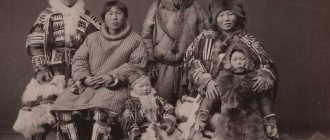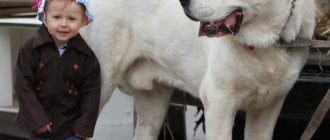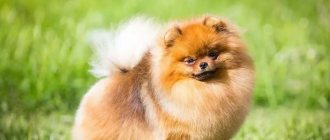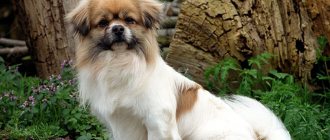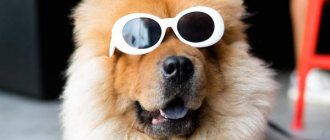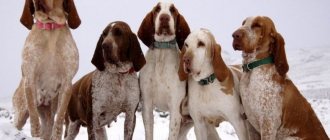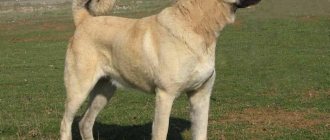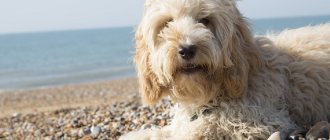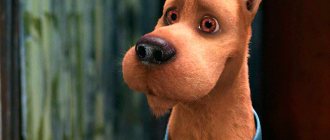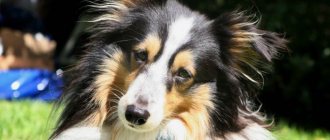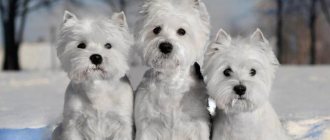Mastiffs are one of the largest and most powerful dogs. All representatives of this family have a calm, balanced temperament, developed intelligence and a rather good-natured character. At the same time, they are excellent watchdogs and are always distrustful of strangers.
Bullmastiff. Photo: Zoltán Kovács-Hegedűs
According to the most likely version, the ancestor of mastiffs is the Molossian Dog (these dogs were common in the territories of the Ancient East, Ancient Greece, Ancient Rome - the first mention of similar dogs dates back to 640 BC). They were used as fighting dogs to hunt wild animals - lions, tigers and even elephants. They also protected homes and livestock, and were often used in fighting arenas. The name “mastiff” itself comes from the Latin “mastinus”, meaning “dog-horse”, which most clearly describes the size of the dog (the weight of some mastiff representatives reaches 150-160 kg).
Story
The name of this breed comes from the name of the Italian city of Mediolana, now known as Milan.
This is due to the fact that the breed contains genes of Italian Molossians from this city. Alexander Kuprin, in his story “Sapsan”, as if told from the perspective of one such dog (the prototype of which is undoubtedly the Sapsan, which belonged to the writer himself), gives a version that the correct name of the breed is “nedelyan”, since in the old days in Rus' there was public persecution wild animals and dogs were organized “once a week.” These dogs were used for hunting and baiting bears. Medelian dogs were in the kennels of many Russian tsars. The Medelyan breed was used to breed the ancient Russian hound. Purebred Medellians cost 5-6 times more than purebred hounds and were comparable in price to noble horses. Medellian dogs were exported abroad in exchange for weapons, horses and textiles.
The reason for the extinction of this dog breed was the ban on bear baiting, introduced in the 1860s. In the second half of the 19th century, the number of the breed began to decline rapidly, and by the beginning of the 20th century, Medellians were preserved only in Gatchina, the place of the imperial hunt. After the revolution they practically disappeared.
Medellian dogs were prized by European dog breeders and were used to improve and maintain local Great Dane breeds, such as the English Mastiff breed.
Moscow diver
The breed, quite famous in the old days, was created on the basis of the kind Newfoundland and the independent Caucasian Shepherd Dog.
The breed was planned to be used for official purposes, in particular to rescue people on the water, but instead the dogs attacked them. In guard duty, they were inferior in working qualities to black terriers, so breeding work was stopped.
Character of the Medellian dog
Despite their rather intimidating appearance, dogs of the Mordash breed have a gentle character. The strength he has makes it possible to knock down even a bear. Of course, we are talking about representatives of the large-sized family.
According to the owners, Medellians have a sharp mind and common sense. Accustomed to hunting wild animals, they will never touch small domestic animals. Large dogs of this breed are not very agile and fast, but they are hardy and tireless. Medelyanka is particularly loyal to its owner.
These pets are balanced and unobtrusive, capable of learning and training. Negative character traits of dogs of this breed include stubbornness and independence.
Other Mastiffs
Let's take a brief look at the features of the other most popular mastiff breeds, which are recognized by the Fédération Cynologique Internationale (FCI).
Brazilian Mastiff (Fila Brasileiro)
A characteristic feature of the breed is the skin dewlap on the neck and belly. The coat is thick and short, solid (shades of yellow) or brindle in color, and may have white markings on the chest, paws and tip of the tail.
Fila Brasileiro. Photo: Leonardo Passero
Another feature of dogs of this breed is the “camel step” - they move with two limbs of one side at the same time. Height from 60 cm, weight from 50 kg, life expectancy 12-15 years. Dogs of this breed are very devoted to their family and will selflessly protect them. They may show aggression towards strangers if they suspect them to be a threat.
Bullmastiff
As the name suggests, this breed was created by crossing a bulldog and an English mastiff. The coat of Bullmastiffs is short, thick, close to the body, red, fawn or brindle in color; there may be small white spots on the chest.
Bullmastiff. Photo: Ian
Height from 60 cm, weight from 50 kg, life expectancy 8-10 years. Bullmastiffs are quite disciplined and patient. They also have an excellent sense of smell. They get along well in families with children and pets and loyally protect their “pack”.
Spanish Mastiff
The skin is loose and thick, creating dewlap around the neck, chest and bottom. The coat is thick, hard, slightly wavy, and lies close to the body. The color is apricot, gray, fawn, red, black, brindle, with or without white markings on the paws, chest.
Spanish Mastiff. Photo: Meu.DOG Site
Height from 75 cm, weight from 50 kg, life expectancy about 10 years. Spanish Mastiffs are intelligent, loyal and caring. They will selflessly protect their owner, family and property. They are somewhat stubborn, so a firm hand is required in training - the dog needs to be made to understand who is in charge.
Neapolitan Mastiff (Mastino Napolitano)
On the face and head, the skin forms characteristic folds. There are skin dewlaps on the neck and lower body. The coat is short, black, blue, gray, and there are also mahogany and isabella colors. There may be small white marks on the chest and fingers.
Mastino napolitano. Photo: https://anvire.ru
Height from 60 cm, weight from 50 kg, life expectancy 7-9 years. The breed is quite phlegmatic and sedentary. Like all mastiffs, he is an excellent watchman and guard, and is not the first to show aggression. Usually it becomes attached to one owner, although it is friendly towards the whole family, including children. If the owner abandons his pet, then over time he will become attached to the new owner and new family, but will never approach the previous one again.
Pyrenean Mastiff (Mastin de los Pyreneos)
This close relative of the Spanish Mastiff has a thick, medium-length coat. The main color is white or light with dark or marbled spots and a clearly defined mask (gray, golden, brown, black, silver, sand color, but not red).
Pyrenean Mastiff. Photo: Jordi-Soriano
Height from 75 cm, weight from 45 kg, life expectancy 10-15 years. Dogs of this breed are intelligent, friendly and affectionate with their owners and family (including children), but are distrustful of strangers. A good defender, can show aggression when a threat arises.
Tibetan mastiff
This breed differs from all representatives of the descendants of Molossian Great Danes by its long, thick coat of black, red or tan color.
Tibetan mastiff. Photo: Kenneth Cole Schneider
Height from 60 cm, weight from 60 kg, life expectancy 10-14 years. As a guard breed, this dog prefers to sleep during the day and stay awake at night. The Tibetan Mastiff is intelligent, but also stubborn. The owner must be a leader in their relationship and maintain strict discipline, since the strong watchdog qualities and independence in decisions of this breed make it distrustful of strangers. She is devoted to her family and will protect it and property.
French Mastiff (Dogue de Bordeaux)
It has a rather squat, muscular build. The dog has thick skin that gathers in folds throughout its body. The coat is very short, close to the body, all shades of red, there may be small white spots on the chest and fingers.
Dogue de Bordeaux. Photo: Udo Kempen
Height from 60 cm, weight from 50 kg, life expectancy 8-10 years. Calm, balanced and caring dog. It becomes very attached to its owner and does not tolerate separation well. He is not the first to show aggression, but if threatened, he will selflessly defend his family.
Japanese Mastiff (Tosa Inu)
In Japan, these dogs took part in dog sumo fights. During the fight, the animals pushed and tried to pin the opponent to the ground, not allowing themselves to bark, squeal and bite. These are large dogs with a massive build, with short, stiff hair of red, fawn, apricot, brindle, black color, and may have white markings on the chest and legs.
Tosa Inu. Photo: Arne Gerisch
Height from 55 cm, weight from 40 kg, life expectancy 10-12 years. A rather capricious breed, in order to subjugate oneself it is necessary to win its respect, at the same time showing firmness in upbringing.
The Mastiff is not the easiest breed to raise. This ancient fighting dog has retained its wayward character, but has long lost its former aggression, and with proper upbringing and treatment, it will become your devoted friend, a brave guard and a caring pet for the whole family.
Pros and cons of whippets
The Whippet is an excellent dog for active people or even hunters. Also, these dogs get along well with small active children - they will never harm them and will always support active games. Elementary education is good for whippets; also, whippets are suitable even for those dog breeders who do not have experience in breeding dogs.
In addition, the whippet has a number of other advantages:
- Thanks to his intelligence and obedience;
- Whippets look incredibly elegant;
- These dogs are infinitely loyal to their owner:
- Always friendly;
- Whippets do not smell and are very clean;
- They are easy to care for;
- Excellently trainable;
- Whippets are well suited for apartment living;
- This is a quiet breed - whippets bark only for business;
- Get along with children;
- Whippets are in good health.
It is worth considering that dogs are active and need constant physical activity. It doesn’t matter what size the apartment or house is - every day the dog needs to be walked for at least three hours twice. If you are not ready for such a waste of time, then it is better not to get this dog. A pile of leaves, a strange cat on the street, birds and small animals - all this is prey for the whippet, who can chase them at any moment.
Whippets also have a number of other disadvantages:
- The hunting instinct is too developed.
- The breed can be willful;
- Daily long walks;
- In case of injury, anesthesia is extremely difficult for dogs;
- They cannot tolerate cold weather.
Breed characteristics
| Short description | |
| Origin: | central Asia |
| Conditions of detention: | House with a garden, spacious house or apartment, aviary |
| Purpose: | Service dogs, working dogs, companion dogs, guard dogs |
| Color: | Different |
| Wool length: | Various |
| Adult dog size: | Height 62-65 cm, weight 40-90 kg |
| Average life expectancy: | 9-15 years |
| Walk: | Twice daily walk required |
| Physical activity needs: | High physical activity needs (regular or daily exercise for more than 3 hours per day) |
| Fédération Cynologique Internationale (FIC) classification: | Group 2: Pinschers and Schnauzers, Molossians, Mountain and Swiss Cattle Dogs; Section 2: Molossians |
| Puppy price: | From 20,000 to 160,000 rubles. The price depends on the specific breed. The most expensive is the Tibetan Mastiff |
Education and training
Those skills and behavioral characteristics that will be instilled in a Pointer puppy from childhood will play an important role in the development of the behavioral manners of an adult. It is very important to start training your dog as a puppy. It is during this period that they are best trained, forming the basis for future behavior.
Where to start:
- Train your puppy to walk on a leash.
- Show him your place (bed). Under no circumstances should you accustom him from an early age to lying on sofas, beds and other furniture.
- Take your first walks in calm and quiet places. Let the puppy adapt to the world around him.
- More serious training commands should begin at an older age.
To ensure successful training, you should avoid:
- aggression;
- anger;
- nervousness.
Training during puppyhood can be presented as a game. If you are older, you will need the help of a specialist. Do not hesitate to seek advice from a professional dog handler. If you want to instill hunting skills in your puppy and train him, but have no experience in this matter, the help of a master is required.
Distinctive features
The height of these mighty hunters at the withers could be more than 120 centimeters. Their main differences from other hunting dogs were drooping ears and folds on the muzzle. According to the description compiled in 1914 by the famous dog handler Viktor Petrovich Priklonsky, the dog had a massive build with a voluminous, muscular neck, widely set and strong paws and coarse, dense hair. “The tail: very strong and long, set low, does not rise high when the dog is excited, and is always lowered in a calm state,” writes Priklonsky.
At the same time, the color of dogs could be very different: from gray and black to mottled (motley).
Whippet Care
The Whippet is an easy dog to care for. Due to its short coat, it does not require frequent bathing or brushing. Its coat is naturally soft and suitable for people with allergies. In addition, the Whippet does not have the characteristic odor that many other breeds suffer from. Lenka passes almost unnoticed in spring and autumn. Whippets should be brushed no more than once a week with a mitt brush made of natural soft bristles. A hard brush can damage the dog's skin, because it is almost not protected by hair. Combing with a whippet is needed not so much for removing dead hair, but for massage. It ensures proper blood flow in the animal’s body.
You should wash your whippet as rarely as possible, about once every three months or as needed. Shampoo should be used for short-haired or hairless breeds of dogs to minimize trauma to the whippet's skin. Frequent bathing causes irritation or allergies. After washing, the dog should be dried with a towel or even a hairdryer so that the dog does not catch a cold.
Whippets should not be allowed to sit in a draft. You need to rinse, clean and dry your ears well so that no diseases arise in them. In winter, when the likelihood of catching a cold is especially high, you need to use dry shampoo or special wet towels; the wool is well combed with a soft comb.
A whippet's eyes should be examined regularly for discharge. Healthy eyes have no redness and shine, the corners are always clean. You can wipe your eyes with a cotton pad moistened with clean water. They can also be wiped with chamomile decoction to avoid possible infections. Since the eyes are the weak point of whippets, at the slightest sign of illness it is worth contacting a veterinarian.
Whippets are dressed in overalls for walks, especially if the weather is cold or wet. But dogs tolerate heat well. You need to walk twice a day - in the mornings and evenings. In the city it is better to walk on a leash, since the breed is curious and energetic, and the dog can mistake any moving object for prey.
Pug Health and Diseases
Unfortunately, we have to admit that pugs are far from the healthiest dogs. Throughout their lives, they have to deal with both congenital and acquired diseases. The most serious of the first category are encephalitis, the cause of which has not yet been fully elucidated by veterinarians, and epilepsy.
The most vulnerable places in the body of representatives of this breed are the eyes and respiratory system. Many pets become partially or completely blind as a result of mechanical damage, infections and other diseases. Cases of seasonal or chronic allergies are common. But the most common problem of this breed is undoubtedly obesity due to excessive appetite and low physical activity. It is not fatal in itself, but it shortens life expectancy, exacerbating existing health problems.
Nutritional Features
The honeydew diet should include the required amount of proteins, carbohydrates and fats. In order for a dog to be healthy and feel great, its average daily amount of food should consist of 70% lean meat and offal. The remaining 30% should include various cereals, eggs, dairy products, fruits and fish. You should not overfeed the animal, or give spicy, salty foods or sweets.
During the active development of a Medellian puppy, you need to add vitamins and minerals to your pet’s food in the form of tablets and solutions. Before purchasing such supplements, you should consult with the breeder and veterinarian.
Dogs of this type can also be fed with ready-made industrial food. Dry food with a high premium protein content is perfect for the muzzle breed.
How to choose a puppy
The main advice when choosing a pug is not new: contact kennels with an excellent reputation or experienced breeders, because animals purchased second-hand or through private advertisements may have not only external or disqualifying defects, but also significant health problems.
Before buying a pug, carefully study the pedigree of the parents, look at the living conditions of the animals, and get to know the puppy. A healthy baby, in addition to a correctly formed skeleton, standard color and the characteristics described in the breed standard, must have a lively, friendly disposition, not be afraid of people and not show aggression, and not be apathetic.
When compiling this article, materials from the following sites were used:
- https://novoston.com/content/medelyan/
- https://k9shleyka.ru/porody/sobaka-goluboj.html
